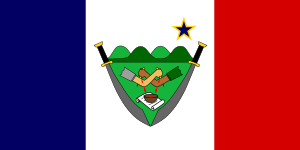Dagohoy rebellion facts for kids
Quick facts for kids Dagohoy rebellion |
|||||||
|---|---|---|---|---|---|---|---|
| Part of the Philippine revolts against Spain | |||||||
|
|||||||
| Belligerents | |||||||
| Boholano people | |||||||
| Commanders and leaders | |||||||
| Francisco Dagohoy Ignacio Arañez Pedro Baguio Bernardo Sanote Maximino Dagohoy (Sendrijas) |
|||||||
| Strength | |||||||
| 2,200 soldiers | 3,000–20,000 followers (in 1744) | ||||||
| Casualties and losses | |||||||
| Unknown | 19,420 surrendered, 395 died in battle, 98 exiled | ||||||
The Dagohoy rebellion was a very long fight for freedom in Philippine history. It is also called the Dagohoy revolution or revolt. This rebellion was led by Francisco Dagohoy, whose real name was Francisco Sendrijas. It happened on the island of Bohol in the Philippines. The fight lasted for about 85 years, from 1744 to 1829.
This rebellion was one of two big uprisings in Bohol during the time Spain ruled the Philippines. The other one was the Tamblot uprising in 1621. That revolt was led by Tamblot, a native priest from Bohol. It was mainly about religious beliefs.
Contents
The Longest Rebellion
The Dagohoy rebellion is famous for being the longest rebellion in the history of the Philippines. It started because of a disagreement with a Spanish priest. Francisco Dagohoy's brother, Sagarino, died during a fight. The priest refused to give Sagarino a proper Christian burial. This made Dagohoy very angry.
Dagohoy decided to fight against the Spanish rulers. He wanted justice for his brother. He also wanted the people of Bohol to be free from Spanish control. Many people joined him because they were also unhappy with Spanish rule. They disliked the high taxes and forced labor.
How the Rebellion Grew
Francisco Dagohoy and his followers went to the mountains of Bohol. They built their own independent community there. This community became a safe place for people who wanted to escape Spanish rule. Many Filipinos from other islands also joined the rebellion.
The rebels lived freely in the mountains. They farmed their own food and had their own laws. The Spanish government tried many times to stop the rebellion. They sent soldiers to fight Dagohoy's forces. But the rebels knew the mountains well. They were very good at fighting in their homeland.
The End of the Rebellion
The rebellion lasted for a very long time, through many Spanish governors. It was hard for Spain to defeat Dagohoy's followers. Finally, in 1829, the Spanish sent a large army to Bohol. This army was led by Governor-General Mariano Ricafort Palacin.
The Spanish forces were much stronger this time. They managed to defeat the rebels. After 85 years, the Dagohoy rebellion finally ended. Many rebels surrendered, and some died in battle. The Spanish government pardoned many of the rebels. They allowed them to live in new villages in the lowlands.
Legacy of Dagohoy
The Dagohoy rebellion is still remembered today. It shows how brave the people of Bohol were. The flag of Bohol province has two native swords on it. These swords represent the Dagohoy and Tamblot revolts. They symbolize that a true Boholano will stand up and fight for what is right.
A town in Bohol is named after Francisco Dagohoy. It is called Dagohoy, Bohol. Vice President Carlos P. Garcia suggested this name. The name "Dagohoy" comes from a local phrase meaning "talisman of the breeze."
There is also a school named in his honor. The Dagohoy Memorial National High School is in Dagohoy, Bohol. These names help keep the memory of Francisco Dagohoy alive. He is remembered as a champion of freedom in the Philippines.
See also
 In Spanish: Rebelión de Dagohoy para niños
In Spanish: Rebelión de Dagohoy para niños


